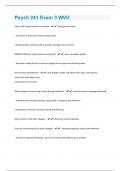Summary
Summary notes for AQA A-Level Chemistry Unit 3.1.3 - Bonding
Summary notes for AQA A-Level Chemistry Unit 3.1.3 - Bonding by an Imperial College London MSci Chemistry graduate. Notes divided into the following sections: States of Matter, Ionic Bonding, Covalent and Dative Covalent Bonds, Metallic Bonding, Shapes of Simple Molecules and Ions, Forces Between C...
[Show more]













